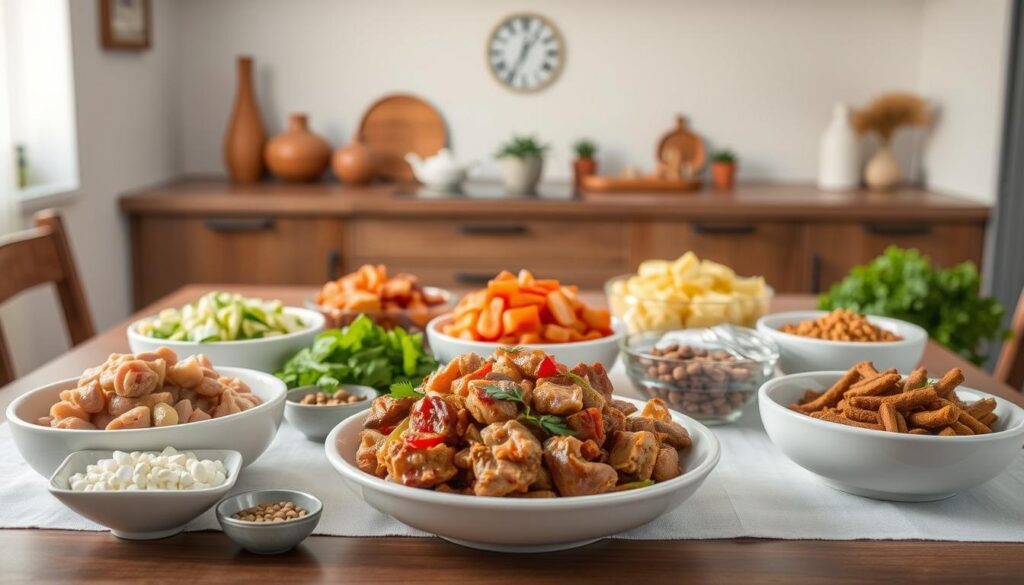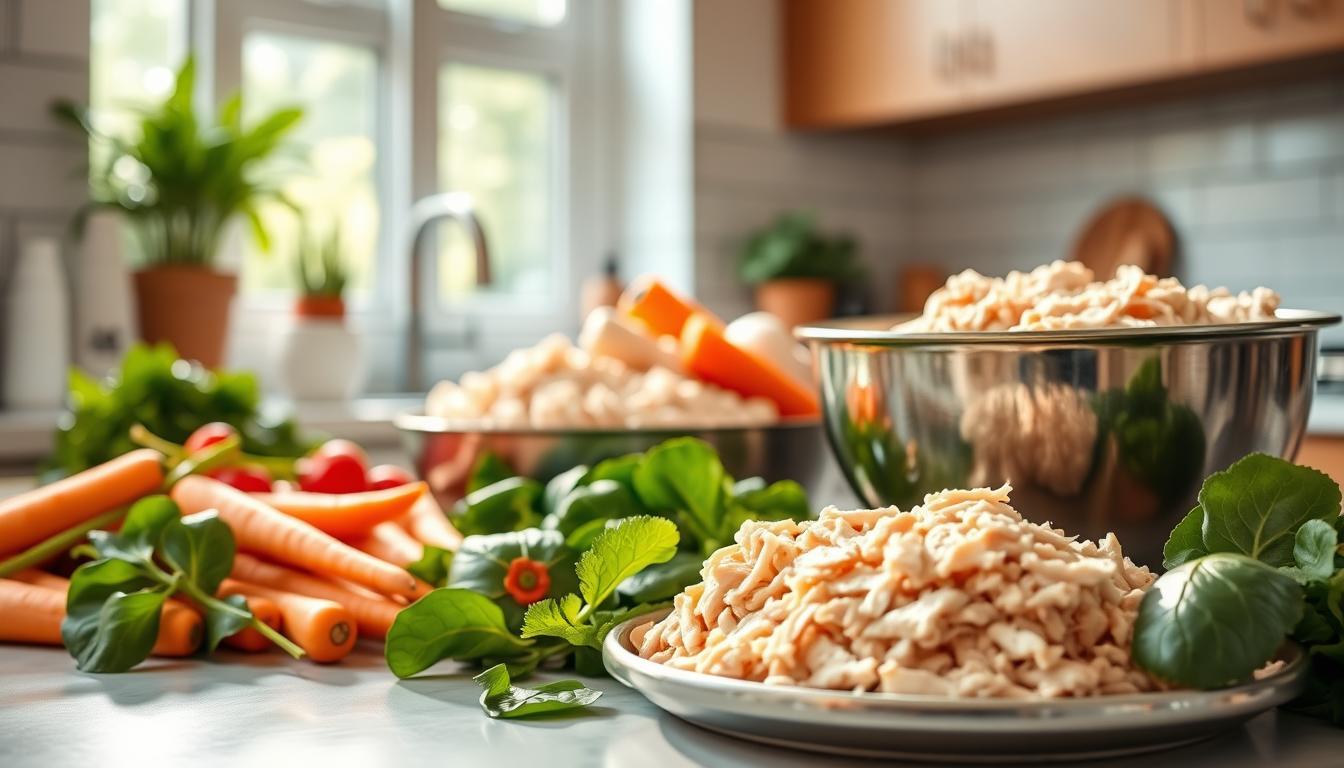Preparing healthy meals for your cat can really help their health. You can make delicious and nutritious meals with the right ingredients. This way, you meet your cat’s special needs.
More cat owners are making homemade cat food for their pets. This choice helps avoid bad stuff in store-bought food. Instead, they use whole foods that keep their cats healthy.
Key Takeaways
- Understand the importance of tailored nutrition for your cat
- Learn how to create healthy, easy-to-make meals
- Discover the benefits of avoiding commercial cat food fillers
- Explore simple recipes to get you started
- Improve your cat’s overall health and well-being
Why Choose Homemade Cat Food?
Homemade cat food is a great choice for those who want a healthier option. Making your cat’s food lets you pick the best ingredients. This way, you avoid bad stuff in commercial food and meet your cat’s needs.
Benefits of Homemade Meals
Choosing fresh, quality ingredients is a big plus of homemade cat food. It can make your cat’s health better, like their digestion and coat. A study found cats on homemade diets had fewer stomach problems than those on commercial food.
“A well-balanced homemade diet can greatly enhance your cat’s quality of life.”
Homemade food is also good for cats with allergies. You can avoid ingredients that cause problems. This helps keep your cat safe from bad reactions.
Common Myths About Homemade Cat Food
Some people think making cat food is hard or takes too much time. But, it’s easy with simple recipes and planning. Another myth is that homemade food lacks important nutrients. But, a vet or nutritionist can help make sure it’s balanced.
Nutritional Advantages
Homemade cat food has many nutritional advantages. You can pick the right ingredients for your cat’s needs. For example, fresh fish gives omega-3s for skin and coat health. Lean meats help keep your cat at a healthy weight.
A good homemade diet keeps your cat healthy. Experts say a balanced diet is key for your cat’s health. So, it’s important to research and plan well.
Essential Ingredients for Cat Food
When making homemade cat food, pick ingredients carefully. Cats need a lot of protein from meat. This keeps them healthy.
Proteins Your Cat Needs
Protein is key for cats. Use chicken, salmon, and turkey. These give cats amino acids they can’t make themselves.
- Chicken: A lean protein that is easily digestible.
- Salmon: Rich in omega-3 fatty acids, supporting skin and coat health.
- Turkey: Another lean protein source that provides variety in your cat’s diet.
Healthy Carbohydrates
Cats don’t need a lot of carbs, but some are good. Sweet potatoes and green peas are healthy carbs to add in small amounts.
- Sweet Potatoes: Rich in fiber and vitamins.
- Green Peas: Provide a good source of fiber and are easily digestible.
Important Vitamins and Minerals
Cats need many vitamins and minerals to stay healthy. Vitamin A in liver helps with vision and immune function. Calcium and phosphorus from bone meal or eggshells are good for bones.
- Vitamin A: Essential for vision, immune function, and skin health.
- Calcium and Phosphorus: Critical for maintaining strong bones and teeth.
Adding these ingredients to your cat food recipes makes sure your cat eats well.
Easy Homemade Cat Food Recipes
You can make yummy and healthy cat food at home. This way, you pick the best ingredients. You can also make food just right for your cat.
Here are some simple and healthy recipes to start with. Each recipe has ingredients and steps to make mealtime easy.
Chicken and Pumpkin Delight
This recipe is full of protein and fiber for your cat. You’ll need:
- 1 pound boneless, skinless chicken breast
- 1/2 cup cooked pumpkin
- 1/4 cup finely chopped carrots
- 1 teaspoon flaxseed oil
Bake the chicken until it’s done. Then, mix it with pumpkin, carrots, and flaxseed oil.

Tuna and Rice Feast
This recipe gives your cat the protein they need. You’ll need:
- 1 can of tuna in water (drained and flaked)
- 1/2 cup cooked white rice
- 1/4 cup steamed green beans
- 1 teaspoon fish oil
Mix all the ingredients together. This recipe is tasty and full of nutrients.
“Feeding your cat a balanced homemade diet can significantly improve their overall health and well-being.”
Beef and Vegetable Mix
This recipe is great for cats who like different textures. You’ll need:
| Ingredient | Quantity |
|---|---|
| Ground beef | 1 pound |
| Cooked sweet potatoes | 1/2 cup |
| Steamed broccoli | 1/4 cup |
| Salmon oil | 1 teaspoon |
Cook the ground beef well. Then, mix it with sweet potatoes, broccoli, and salmon oil. This recipe is full of nutrients your cat will love.
Adding these easy homemade cat food recipes to your cat’s diet is a great idea. It ensures they get the nutrients they need to stay healthy.
Cooking Methods for Cat Food
Choosing how to cook cat food matters a lot. Different ways can change how tasty, healthy, and easy to eat the food is.
Boiling vs. Baking
Boiling and baking are two ways to cook cat food. Boiling means cooking in water until it’s soft. But, it might lose some nutrients if you throw away the water.
Baking uses dry heat. It keeps more nutrients and can make some foods crispy. But, you have to watch it so it doesn’t get too hard or dry.
| Cooking Method | Nutrient Retention | Texture |
|---|---|---|
| Boiling | Moderate | Soft |
| Baking | High | Variable |
Food Processors and Blenders
Food processors and blenders make making cat food easier. They mix everything well, so your cat gets the right mix of nutrients.
It’s key to get the right mix of texture. Some cats like it smooth, others like it chunky.
Slow Cooking for Tender Meals
Slow cooking is great for making cat food. It cooks the food slowly, making meat tender and easy to digest.
To slow cook, just put the food in a slow cooker and set it. It’s perfect for those who are always busy but want to feed their cat well.
By picking the best cooking method, you can make sure your cat eats well. Try different ways to see what works best for your pet.
Supplementing Homemade Cat Food
When making homemade cat food, think about adding supplements. A good recipe is key, but supplements help fill in the gaps. They make sure your cat gets all the nutrients they need to stay healthy.
Importance of Taurine
Taurine is very important for cats. It helps their hearts and eyes. Since cats can’t make enough taurine, they need it in their food. Make sure to add taurine-rich foods or supplements to their meals.
Omega-3 Fatty Acids
Omega-3 fatty acids are great for your cat’s skin, coat, and health. They also help the heart and reduce swelling. Fish oil is a good source of omega-3s and can be added carefully to their food.
Adding Probiotics
Probiotics keep your cat’s digestive system healthy. They help your cat absorb nutrients better and boost their immune system. When picking a probiotic, choose one made for cats.
Here are some tips for adding supplements to your cat’s food:
- Talk to your vet to find the right supplements for your cat.
- Start with a little and watch how your cat reacts.
- Pick high-quality supplements from trusted brands.
| Supplement | Benefits | Sources |
|---|---|---|
| Taurine | Heart health, vision | Meat, fish, taurine supplements |
| Omega-3 Fatty Acids | Skin, coat, heart health | Fish oil, flaxseed oil |
| Probiotics | Digestive health, immune system | Probiotic supplements, yogurt |
Homemade Treats for Cats
Making treats for your cat at home is fun. It lets you choose what’s in their snacks. Homemade treats are a great way to reward your cat with something healthy.
Quick Catnip Treats
Catnip is a hit with cats. Making catnip treats is easy. You’ll need:
- 1 cup of whole wheat flour
- 1/2 cup of oat flour
- 1/4 cup of catnip
- 1/4 cup of water
Mix the dry stuff together. Then add water to make dough. Roll it out and cut into shapes with a cookie cutter. Bake at 350°F for 15 minutes.

Salmon Bites Recipe
Cats love fish, and salmon is good for them. To make salmon bites, you need canned salmon, whole wheat flour, and an egg.
- Mix the salmon, flour, and egg in a bowl.
- Make small balls and flatten them a bit.
- Bake at 350°F for 10-12 minutes or until they’re firm.
These bites are tasty and full of protein and omega-3 fatty acids. They’re a healthy snack for your cat.
Crunchy Chicken Chips
Try making chicken chips for a crunchy treat. Slice cooked chicken into thin strips. Then bake until they’re crispy.
- Use 1/2 cup of cooked, shredded chicken
- Spread on a baking sheet and bake at 200°F for 2-3 hours or until crispy.
These crunchy chicken chips are a tasty alternative to store-bought treats. Keep them in an airtight container.
Storing and Serving Homemade Cat Food
To keep your cat’s homemade meals fresh and safe, it’s crucial to store and serve them correctly. Proper storage and serving practices not only maintain the quality of the food but also ensure your cat’s health and well-being.
Best Practices for Refrigeration
When storing homemade cat food in the refrigerator, it’s essential to follow a few guidelines to maintain freshness. Use airtight containers to prevent moisture and other contaminants from affecting the food. Label the containers with the date they were prepared, and ensure they are consumed within three to five days.
Tips for Refrigeration:
- Store food in shallow containers to help it cool quickly and evenly.
- Keep the refrigerator at a consistent temperature below 40°F (4°C).
- Avoid overcrowding the refrigerator to ensure good air circulation.
How to Safely Freeze Homemade Meals
Freezing is an excellent way to extend the shelf life of homemade cat food. To freeze safely, portion the food into airtight containers or freezer bags, making sure to remove as much air as possible before sealing. Label the containers or bags with the date and contents.
Freezer Storage Tips:
- Freeze in small portions to make thawing easier and reduce waste.
- Use freezer-safe containers or bags to prevent freezer burn.
- Consume frozen meals within three to six months for optimal quality.
Serving Sizes for Different Age Groups
The serving size for homemade cat food varies based on the cat’s age, size, and activity level. Generally, cats require 2-4% of their body weight in food per day. For example, a 10-pound cat would need 3-6 ounces of food daily.
| Age Group | Daily Serving Size |
|---|---|
| Kittens (under 6 months) | 3-4% of body weight |
| Adult Cats | 2-3% of body weight |
| Senior Cats (over 7 years) | 1.5-2.5% of body weight |
By following these guidelines for storing and serving homemade cat food, you can ensure your cat enjoys fresh, nutritious meals that support their overall health.
Common Mistakes to Avoid
When making homemade cat food, some mistakes can harm your cat. Knowing these mistakes helps keep your cat healthy.
Overlooking Nutritional Balance
Many cat owners forget about nutritional balance. Cats need proteins, fats, vitamins, and minerals. It’s key to make sure your cat food has all these. For example, cats need taurine for heart and eye health.
Without the right nutrients, cats can get sick. Lack of vitamin A causes night blindness. Not enough calcium can hurt their bones. Always check with a vet to get the right mix for your cat.
Unsuitable Ingredients to Avoid
Some foods are bad for cats. Onions, garlic, and chocolate are toxic. Onions and garlic can cause anemia. Also, don’t give cats bones because they can hurt their insides.
Using low-quality ingredients is also risky. Always pick fresh, good ingredients. And handle them safely to avoid contamination.
Introducing New Foods Gradually
Adding new foods too fast can upset a cat’s stomach. Start by mixing a little new food with their old food. Slowly add more over days or weeks.
This slow introduction helps avoid stomach problems. Watch how your cat reacts to new foods. Some cats might be allergic.
By avoiding these mistakes, you can make healthy homemade cat food. This food will meet your cat’s needs and keep them healthy.
Transitioning to Homemade Cat Food
Switching your cat to homemade food needs a slow start. This helps avoid upset stomachs. A careful plan makes the change easier and keeps your cat healthy.
Gradual Switching
Begin by adding a little homemade food to their usual diet. Slowly add more homemade food over 7-10 days. This lets their stomach get used to it.
Health Monitoring
Watch your cat closely for any signs of upset stomach. Look for diarrhea, vomiting, or changes in energy and coat. Their overall health matters a lot.
Veterinary Consultation
If your cat shows any bad reactions, talk to your vet. They can give advice and help make the food right for your cat.
Slowly switching to homemade food and watching your cat’s health helps. You’ll give them a diet that’s good for them.
FAQ
What are the benefits of homemade cat food recipes?
Homemade cat food lets you tailor your cat’s diet. It avoids bad stuff in store food. It makes sure your cat gets all the nutrients they need.
How do I ensure my homemade cat food is nutritionally balanced?
For balanced food, use animal proteins, healthy carbs, and key vitamins and minerals. Don’t forget taurine, omega-3s, and probiotics.
Can I use any ingredients in my homemade cat food?
No, some foods are bad for cats. Always check what you use. Start new foods slow to avoid upset stomachs.
How do I store homemade cat food to maintain freshness?
Keep food fresh by refrigerating right and freezing safely. Give the right amount for your cat’s age.
How often should I feed my cat homemade food?
Feeding times vary by age, size, and health. Talk to a vet to find the best schedule for your cat.
Can I make homemade cat treats, and what are some healthy options?
Yes, you can make treats. Try catnip treats, salmon bites, or chicken chips. They’re fun rewards for your cat.
How do I transition my cat to homemade cat food?
Switch foods slowly. Watch your cat’s health. If problems arise, see a vet.
Are there any common mistakes to avoid when making homemade cat food?
Yes, don’t forget about nutrition, use safe ingredients, and introduce foods slowly. This avoids stomach problems.




